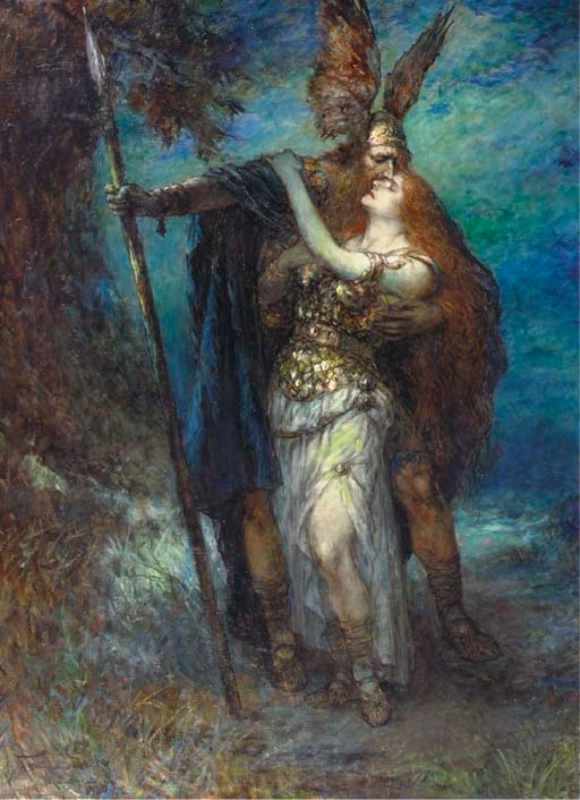Wotan is the King of the Gods in Richard Wagner’s opera Der Ring des Nibelungen (The Ring of the Nibelung), a cycle of four German-language epic music dramas: Das Rheingold (The Rhinegold), Die Walküre (The Valkyrie), Siegfried, and Götterdämmerung (Twilight of the Gods). The works are based loosely on characters from Germanic heroic legend, namely Norse legendary sagas and the Nibelungenlied. It is often referred to as the Ring cycle, Wagner’s Ring, or simply The Ring. The plot revolves around a magic ring that grants the power to rule the world, forged by the Nibelung dwarf Alberich from gold he stole from the Rhine maidens in the river Rhine. With the assistance of the god Loge, Wotan – the chief of the gods – steals the ring from Alberich, but is forced to hand it over to the giants Fafner and Fasolt in payment for building the home of the gods, Valhalla, or they will take Freia, who provides the gods with the golden apples that keep them young. Wotan’s schemes to regain the ring, spanning generations, drive much of the action in the story. His grandson, the mortal Siegfried, wins the ring by slaying Fafner (who slew Fasolt for the ring) – as Wotan intended – but is eventually betrayed and slain as a result of the intrigues of Alberich’s son Hagen, who wants the ring for himself. Finally, the Valkyrie Brünnhilde – Siegfried’s lover and Wotan’s daughter who lost her immortality for defying her father in an attempt to save Siegfried’s father Sigmund – returns the ring to the Rhine maidens as she commits suicide on Siegfried’s funeral pyre. Hagen is drowned as he attempts to recover the ring. In the process, the gods and Valhalla are destroyed. The Old Norse Edda supplied much of the material for Das Rheingold, while Die Walküre was largely based on the Völsunga saga. Siegfried contains elements from the Eddur, the Völsunga saga and Thidrekssaga. The final Götterdämmerung draws from the 12th-century German poem, the Nibelungenlied, which appears to have been the original inspiration for the Ring.
| Alias Wotan |
| Real Names/Alt Names Wotan |
| Characteristics Myths & Legends, Deity, Immortal, Prehuman Epoch, German |
| Creators/Key Contributors ○ |
| First Appearance German mythology |
| First Publisher ○ |
| Appearance List Literary: Nibelungenlied (c. 1200), Prose Edda (c. 1220 CE), Poetic Edda (c. 1270 CE), Völsunga saga (13th century), et. al., Richard Wagner’s Der Ring des Nibelungen (1848-1874), William Morris’s Sigurd the Volsung (1876), The Story of Siegfried by James Baldwin and Howard Pyle (1899), The Heroes of Asgard: Tales from Scandinavian Mythology by Keary and Keary (1909), In the Days of Giants: A Book of Norse Tales by Abbie Farwell Brown (1902), J. R. R. Tolkien’s The Legend of Sigurd and Gudrún (1930), et. al. Comics: National Comics #11. |
| Sample Read The Story of Siegfried [Internet Archive] |
| Description Wotan is the King of the Gods in Richard Wagner’s opera Der Ring des Nibelungen (The Ring of the Nibelung), a cycle of four German-language epic music dramas: Das Rheingold (The Rhinegold), Die Walküre (The Valkyrie), Siegfried, and Götterdämmerung (Twilight of the Gods). The works are based loosely on characters from Germanic heroic legend, namely Norse legendary sagas and the Nibelungenlied. It is often referred to as the Ring cycle, Wagner’s Ring, or simply The Ring. The plot revolves around a magic ring that grants the power to rule the world, forged by the Nibelung dwarf Alberich from gold he stole from the Rhine maidens in the river Rhine. With the assistance of the god Loge, Wotan – the chief of the gods – steals the ring from Alberich, but is forced to hand it over to the giants Fafner and Fasolt in payment for building the home of the gods, Valhalla, or they will take Freia, who provides the gods with the golden apples that keep them young. Wotan’s schemes to regain the ring, spanning generations, drive much of the action in the story. His grandson, the mortal Siegfried, wins the ring by slaying Fafner (who slew Fasolt for the ring) – as Wotan intended – but is eventually betrayed and slain as a result of the intrigues of Alberich’s son Hagen, who wants the ring for himself. Finally, the Valkyrie Brünnhilde – Siegfried’s lover and Wotan’s daughter who lost her immortality for defying her father in an attempt to save Siegfried’s father Sigmund – returns the ring to the Rhine maidens as she commits suicide on Siegfried’s funeral pyre. Hagen is drowned as he attempts to recover the ring. In the process, the gods and Valhalla are destroyed. The Old Norse Edda supplied much of the material for Das Rheingold, while Die Walküre was largely based on the Völsunga saga. Siegfried contains elements from the Eddur, the Völsunga saga and Thidrekssaga. The final Götterdämmerung draws from the 12th-century German poem, the Nibelungenlied, which appears to have been the original inspiration for the Ring. |
| Source Der Ring des Nibelungen – Wikipedia |

